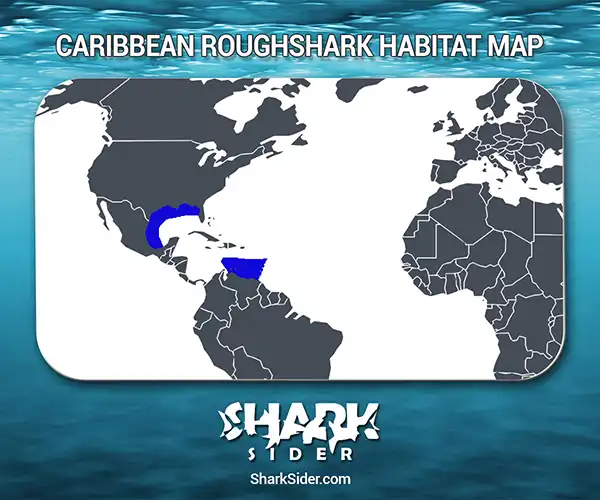The Caribbean Roughshark (Oxynotus caribbaeus) is a small, rare, shark that stays close to the ocean bottom in the Gulf of Mexico and the Caribbean Sea. Little is known about the life history of this enigmatic species, which was described in 1961 yet was only lately observed in its natural environment.
There’s no chance that you’ll mistake this species for the very similar-sounding Caribbean Reef Shark (a large requiem shark).
Like the other four members of the Oxynotus genus, which together comprise the Angular Roughshark family (Oxynotidae), this deep-sea creature is an unusual, chubby-looking fish that looks nothing like your typical, torpedo-shaped shark. It has a short, blunt snout, two high dorsal fins bearing sharp spines, a compressed body with a triangular in cross-section, and atypically large dermal denticles that make the skin feel very rough.
The light, greyish skin is patterned with dark bands and blotches spread over the head, body, and tail, which are separated from prominent lighter areas over the pectoral and pelvic fins.
Caribbean Roughshark Facts
Adult males reach a maximum size of only half a meter (1.7 ft) long. As is typical for dogfish, females are thought to grow even longer than the males.
Recently, a photographer captured spectacular footage of a free-swimming Caribbean Roughshark in its natural habitat. The images were taken off the coast of Honduras from a deep-diving submarine, whose mission is to enable public access to the little-explored, fascinating environment of the deep ocean.
Habitat and Range
Map Of The Caribbean Roughshark Shark’s Habitat

The Caribbean Roughshark can be found in the western central Atlantic Ocean. Its geographic distribution encompasses the waters off of the Bahamas, Honduras, Venezuela, and possibly elsewhere in the Caribbean Sea.
The habitat of this shark is the upper continental slopes of that range. It has been recorded at depths of approximately 400 to 600 m (~1300 to 2000 ft), but it may occupy shallower or deeper water.
Feeding Behavior
Like other Roughsharks, this species has an unusual dentition, with spear-shaped upper teeth, and blade-like teeth in the lower jaw. Most likely this shark feeds on bottom invertebrates and fishes, but for now its diet remains unobserved.
Social Behavior and Breeding
Literally nothing is known about the behavior of the Caribbean Roughshark. Based on the biology of its close relatives though, such as the Sailfin Rough Shark and the Prickly Dogfish, this species must have an ovoviviparous breeding system. That means that it gives birth to live pups that develop after hatching from eggs inside the mother.
Humans and Conservation
This species, and other members of the family, are not the target of fisheries. Such sharks are an uncommon bycatch, because they occupy deeper waters and stick close to the sea bottom. If caught accidentally, Oxynotids are sometimes processed for fish meal and oil, and are also preserved for human consumption, by smoking and salting.
The IUCN Red List assesses this species as “Data deficient”, because so little is known. The extent of such biological mysteries remaining in the deep sea should provide the perfect inspiration for any budding marine biologists out there!
Sources
Kyne PM, Carlson JK, Ebert DA, Fordham SV, Bizzarro JJ, Graham RT, Kulka DW, Tewes EE, Harrison LR & Dulvy NK (editors) (2012). The Conservation Status of North American, Central American, and Caribbean Chondrichthyans. IUCN Species Survival Commission Shark Specialist Group, Vancouver, Canada.
Leandro L (2004). Oxynotus caribbaeus. In: IUCN 2012. IUCN Red List of Threatened Species. Version 2012.2.
Marine Species Identification Portal
